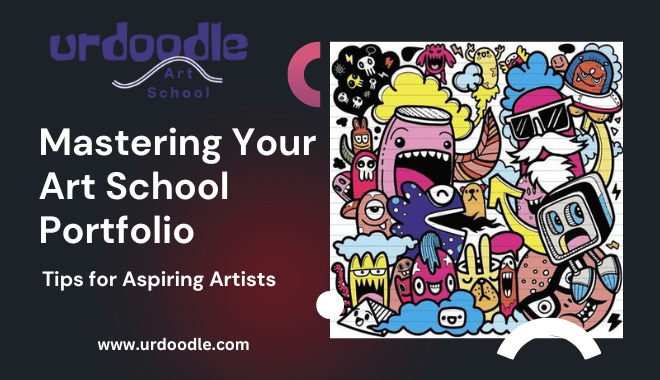Creating an art school portfolio can be an intimidating yet exhilarating journey for aspiring artists. Whether you’re applying to traditional art schools or online programs, a standout portfolio is crucial for showcasing your skills, creativity, and potential. This comprehensive guide provides actionable tips, clear organization, and insights to help you craft a portfolio that will captivate art school admissions committees.

Understanding the Purpose of Your Art School Portfolio
Creating an art school portfolio is not just about compiling your best works—it’s about crafting a narrative that highlights your artistic journey, your skills, and your potential. This section delves deeper into the multifaceted purpose of an art school portfolio, providing insights that will guide you in developing a comprehensive and compelling collection of works that speak to who you are as an artist.
Showcasing Technical Skills
At its core, an art school portfolio is a testament to your technical prowess. Admissions committees look for evidence of your ability to handle different mediums and techniques. Whether it’s the precision of your brushstrokes in a painting, the intricate details in a pencil sketch, or the innovative use of materials in a sculpture, your portfolio should reflect your mastery of the fundamentals of art. This is your chance to demonstrate a solid foundation in the basics, including composition, color theory, and perspective, which are crucial components of any art education.
Expressing Your Unique Creativity
Beyond technical skills, your portfolio should be a window into your creative mind. Art schools are interested in your individual artistic voice—what sets you apart from other applicants. This involves showcasing your ability to think outside the box and present fresh ideas and concepts. Your portfolio should reflect your capacity to innovate and communicate through your art, offering a unique perspective that captures the imagination of the viewer. Whether through thematic exploration or experimental techniques, your work should convey a distinct personality and style.
Reflecting Growth and Potential
Art is a journey, and your portfolio should illustrate your development as an artist. Admissions committees are not only interested in where you are now but also in your potential for growth. By including pieces that highlight your progress over time, you can demonstrate your willingness to learn, adapt, and refine your skills. This can include early works that chart your initial artistic explorations, juxtaposed with more recent creations that show how you’ve evolved. Including unfinished pieces or sketches can also be beneficial, as they provide insight into your creative process and problem-solving abilities.
Aligning with School Requirements
Each art school has its own set of requirements and expectations for portfolios, and it’s crucial to tailor your submissions accordingly. This involves researching each institution’s guidelines, which may include specific themes, preferred mediums, or a required number of pieces. Aligning your portfolio with these requirements not only demonstrates your attention to detail but also shows your commitment to meeting the school’s standards. Customizing your portfolio for each application reflects your understanding of the school’s values and your willingness to integrate into their artistic community.
Telling a Cohesive Story
Your portfolio should do more than just display individual works; it should weave them into a cohesive narrative that tells your story as an artist. Consider the flow and sequence of your pieces—how they relate to one another and the overall message they convey. This narrative approach helps the admissions committee understand your artistic vision and the themes or ideas that drive your work. An artist statement can complement your portfolio by providing context and deeper insights into your creative inspirations and objectives.
By understanding and addressing these key purposes, you can create a portfolio that not only meets the technical and creative standards of art schools but also resonates on a personal and emotional level with the admissions committees. This comprehensive approach will enhance your chances of making a memorable impression and securing a place in the art program of your choice.
Steps to Craft a Compelling Art School Portfolio
Creating an art school portfolio requires strategic planning and thoughtful execution. It’s not just about showcasing your best work; it’s about telling your story as an artist and demonstrating your potential to thrive in an academic environment. Below are detailed steps to help you create a portfolio that not only meets art school requirements but also sets you apart from other applicants.
1. Thoroughly Research Art School Requirements
Before you start compiling your work, invest time in understanding the specific requirements of each art school to which you are applying. Requirements can vary greatly between institutions, so it’s essential to tailor your portfolio for each application.
Key Considerations:
- Number of Pieces: Most schools specify a range or limit on the number of artworks.
- Mediums Accepted: Some schools might prefer or require certain mediums (e.g., digital, traditional, mixed media).
- Format and Submission Method: Determine if the school prefers physical portfolios, digital submissions, or both.
- Theme or Conceptual Focus: Some programs may request portfolios centered around a particular theme or concept.
2. Curate a Diverse Collection of Your Best Work
Diversity in your portfolio demonstrates your versatility and breadth as an artist. Aim to include various styles, techniques, and mediums to reflect your wide-ranging skills.
Strategies for Curation:
- Balance of Mediums: Include a mix of mediums such as drawing, painting, sculpture, digital art, etc.
- Variety in Subjects: Present a range of subject matter, including portraits, still lifes, abstract concepts, and landscapes.
- Style Exploration: Showcase your ability to work in different styles, from realism to abstraction.
- Technical Mastery: Choose pieces that best demonstrate your technical skills and artistic mastery.
3. Prioritize Quality Over Quantity
While it might be tempting to include as much work as possible, it’s crucial to focus on the quality of your submissions. Admissions committees prefer seeing fewer pieces of high quality rather than many mediocre ones.
Tips for Quality Selection:
- Technical Excellence: Each piece should display a high level of technical skill.
- Emotional Resonance: Include pieces that convey strong emotions or tell compelling stories.
- Originality: Ensure your work reflects your unique artistic voice and creativity.
4. Illustrate Growth and Potential
Art schools are interested in your current abilities and your potential for growth. Use your portfolio to illustrate your artistic journey and future potential.
Ways to Demonstrate Growth:
- Chronological Selection: Include earlier works alongside recent pieces to show progression.
- Process Work: Incorporate sketches or rough drafts to provide insight into your creative process.
- Reflective Pieces: Add works that demonstrate your ability to learn from and improve upon previous projects.
5. Seek Constructive Feedback
Feedback is essential in refining your portfolio. Engage with peers, mentors, or art teachers to gain diverse perspectives on your work.
Methods for Gathering Feedback:
- Portfolio Reviews: Participate in formal portfolio review sessions offered by schools or art organizations.
- Peer Critiques: Engage with fellow artists for honest feedback and suggestions.
- Iterative Process: Use the feedback received to revise and enhance your portfolio iteratively.
6. Perfect Your Presentation
The way you present your portfolio is as important as the content itself. A well-organized and professional presentation can significantly impact the impression your work leaves.
Presentation Tips:
- High-Quality Images: Ensure digital images are high resolution and accurately represent the original work.
- Consistent Formatting: Maintain a uniform format, whether it’s in the sizing of images or font used for descriptions.
- Professional Layout: Organize your portfolio in a logical order, perhaps starting with your strongest piece or grouping by theme or medium.
7. Craft a Cohesive Narrative
Your portfolio should convey a cohesive narrative about you as an artist. This narrative not only ties your pieces together but also provides context for your artistic journey and vision.
Building Your Narrative:
- Thematic Consistency: While including diverse works, aim for a unifying theme or concept.
- Artist Statement: Prepare a concise and thoughtful artist statement to accompany your portfolio, offering insights into your motivations and creative process.
- Personal Touch: Infuse your personality and artistic voice into the portfolio, making it uniquely yours.
8. Avoid Common Pitfalls
There are several common mistakes to avoid when compiling your portfolio, which can detract from your work’s impact.
Pitfalls to Avoid:
- Ignoring Guidelines: Failing to adhere to specific school guidelines can result in disqualification.
- Overloading Similar Works: Avoid redundancy; ensure each piece adds unique value.
- Neglecting the Process: Schools value the artistic process; include evidence of your creative journey.
- Rushing Through: Start early to allow ample time for thoughtful curation and refinement.
- Underestimating Presentation: A poorly presented portfolio can undermine the quality of your work.
Additional Resources and Support
- Workshops and Online Courses: Opportunities for skill enhancement.
- Community Engagement: Benefits of participating in artist communities and forums.
- urdoodle.com Resources: Internal links to relevant articles and guides for further learning.
Conclusion
Crafting an outstanding art school portfolio requires careful planning, attention to detail, and a commitment to showcasing your best self as an artist. By following these tips and focusing on creating a cohesive, diverse, and well-presented portfolio, you’ll be well-equipped to capture the attention of art school admissions committees and take a significant step toward your artistic aspirations.
For more insights and resources, explore additional guides and articles on urdoodle.com to enhance your artistic journey.



